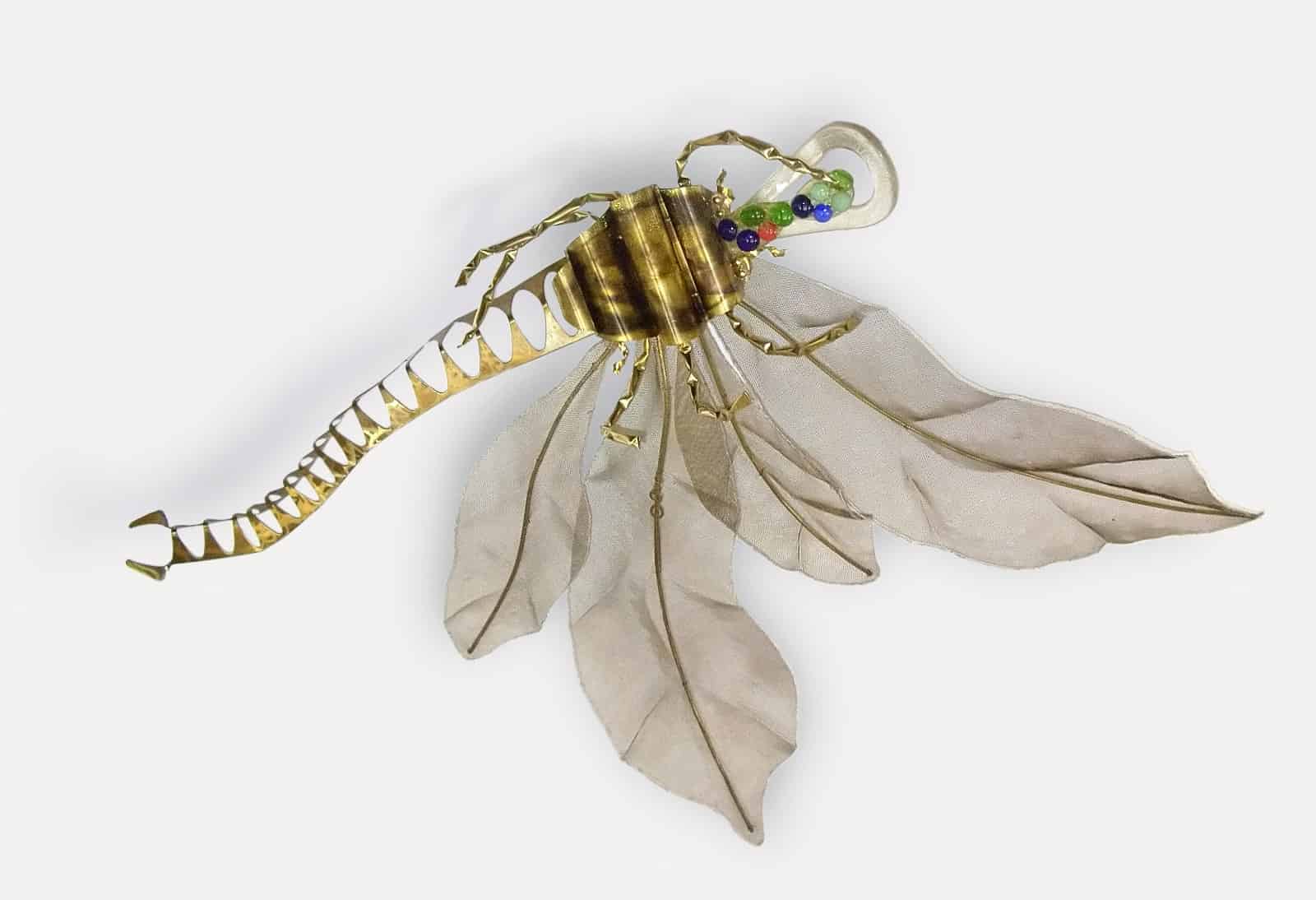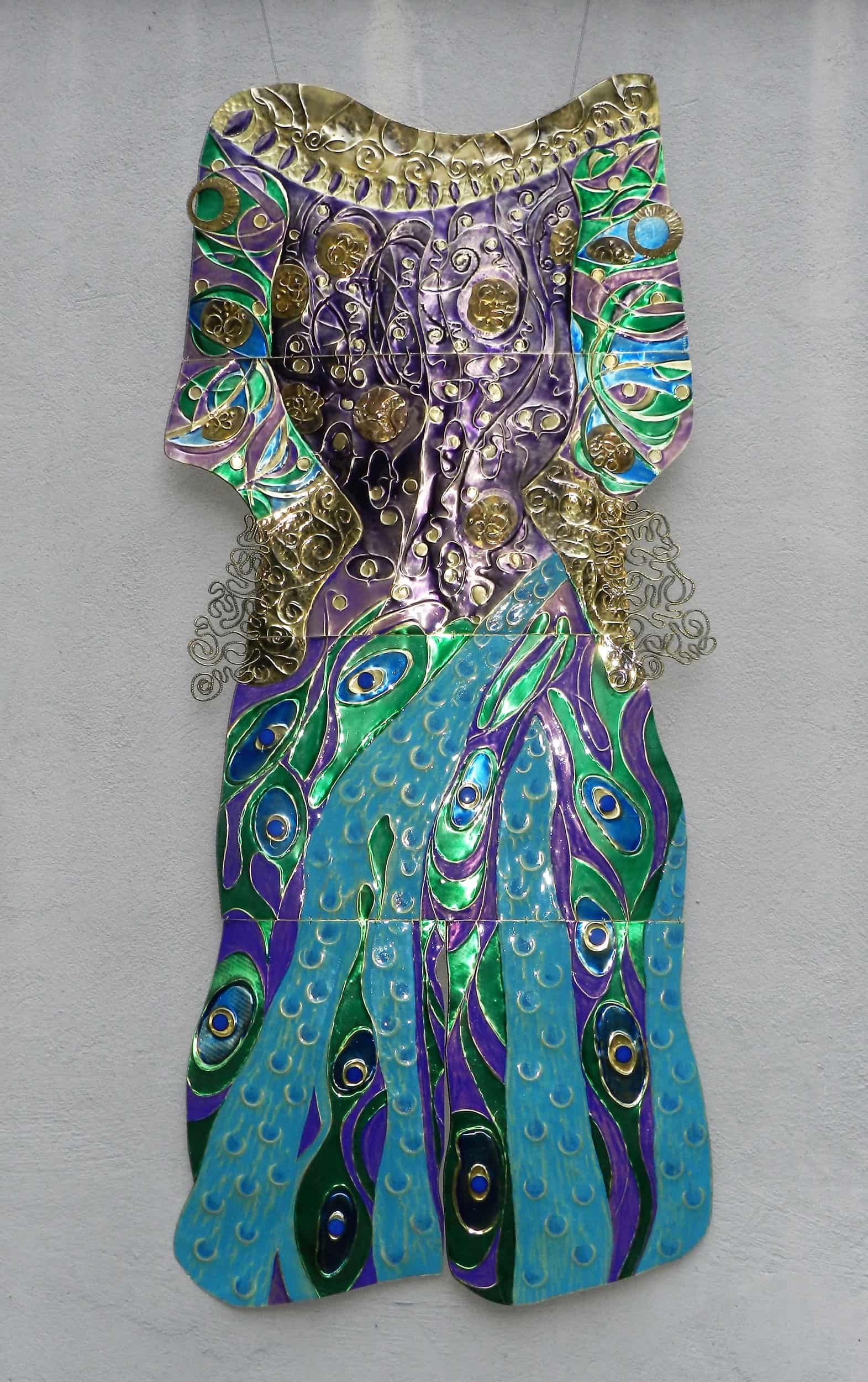[polska wersja językowa poniżej]

Barbara Munzer, private archive, courtesy of the artist
The Warsaw historic art studios are gradually sinking into oblivion. Overshadowed by huge galleries, they are not commonly thought about or acknowledged, which does not do justice to these treasures in the cultural heritage of Warsaw. They are a unique evidence of artistic legacy and contribute to formation of the city’s cultural identity, which is why they should be seen as an added value. It is crucial to inform people living in the city about the activities carried out in these studios, to spread knowledge about them and the work of their occupants. With this purpose in mind, the Contemporary Lynx magazine in cooperation with the Warsaw Historic Art Studios team prepared a series of articles entitled “Art Studios Going Online” in which we introduce to our readers artists working in historic studios, their works and the very place they where they create. In this article we proudly present the studio of Barbara Munzer.
Barbara Munzer is undoubtedly a versatile artist who retreats to her small studio to create jewellery compositions as well as large spatial objects made of metal and decorated with ceramics, enamel and nacre. The studio itself is located in the basement of a residential building at Wiejska street, which is in the very centre of Warsaw. Her unique compositions include characteristic elements of several fields of art, such as jewellery, decorative metalwork and costume design. Barbara has been occupying her studio since the early 1980s. The place itself is truly unique. It is completely filled with masterfully crafted metal artworks. There is a workbench with a lot of instruments, materials and semi-finished products made of metal at different stages of processing spread all over the surface. Over a desk there are shelves full of jars with materials, tools and fixatives. Many photos can be seen there too, presenting models or jewellery inspirations. The drawers hide various art supplies, liquid and powder enamels and metal varnishes to ensure colour and shine, while boxes and cabinets are filled with sheets of metal, wires, metal tapes and various “treasures” from industrial skips and flea markets. There are no precious stones, but there is an idea and an artistic thought: what can be made from seemingly banal materials. In the studio we can also find sketches, drawings and paintings. What really comes first and adds the unique character to the place are Barbara’s works. On the walls hang metal robes, mainly in golden and red tones and reflections of light on them are spectacular. The metal glows, attracting everyone’s attention. Along the longest wall there are works standing on the floor. They are packed and secured, and fill the studio completely. The studio, in fact, could as well be called “a creator’s hideaway”. Even at first sight it is noticeable that the studio is a really precious place for the artist who has been working there for many years.
In this interview with Contemporary Lynx Barbara Munzer will talk about how she acquired the apartment which she transformed into a studio, how the place influenced her as an artist through the years, about the atelier as the space for contemplation and about creative work inspired by René Jules Lalique, Carl Fabergé and paintings by Gustav Klimt and Alfons Mucha. Enjoy reading.
Sylwia Krasoń: As a designer of jewellery and costumes you worked on many film productions and for a lot of fashion houses. Which project or which employer were the most memorable for you?
Barbara Munzer: I would say it was working for the Moda Polska fashion company! My task was to design and make jewellery which would match the outfits to be presented at the fashion show. The show took place in Warsaw in May 1988. The outfits with matching jewellery were well received by the audience and we received a generous round of applause at the jubilee show. When the host mentioned my name as the jewellery creator the applause was so much more rapturous, which is why on the next day nobody mentioned me as a contributor. The persons who attended this second show and told me that I was not publicly mentioned were disgusted by this fact, just like me. What can I say – a nasty reality! Or maybe not? Elżbieta Łukomska (Historic Museum of the Capital City of Warsaw) described the event as follows: “I witnessed an incredible magic, I saw how outfits changed when this jewellery was added, how they acquired a specific character, charm and style. The jewellery became for the presented outfits what the French would describe as: Une veritable note a la page….”
When I think about other challenges, I must admit I liked cooperating with fashion historians and preparing props for historical films (“Copernicus”, “Czarne chmury” [Black clouds], “Potop” [The Deluge]) and for plays broadcast on TV.
What I liked least was preparing individual exhibitions because I used to get very tired while placing and installing my works in the provided space (although there were gentlemen helping me in these endeavours). There is one particular exhibition which had a special significance for me. The event was held in 1999 at the Castle of the Mazovian Dukes in Płock. This was where the Mazovian Museum – Art Nouveau Museum had its seat. The vernissage was really festive, there were artists performing and the event culminated with a few of my works being purchased to be included in a museum collection. The museum director, Tadeusz Zaremba included the following pleasant words in the exhibition catalogue: “When you look at the works presented it is hard to believe that these are creations of a woman. Nevertheless, the subtlety, refined shapes, the selection of details and attention devoted to them confirm the feminine nature of these works. The exhibition confirms the power and endless possibilities which talented humans penetrate, as well as multitude and diversity of forms of artistic expression.”

Pracownia plastyczna Amelii Barbary Munzer-Dąbrowskiej
SK: As time passed the sophisticated patterns which are characteristic for jewellery transformed into monumental objects or, as you call them, ‘Spatial Objects’. When did you start to experiment with sizes? Do you remember your first attempts to create such objects?
BM: Out of all possible types of jewellery necklace became my absolute favourite. It is bigger and offers me more possibilities. At some point these necklaces grew to such impressive sizes (which was emphasized by the names of some of them, like “The Big Night”, “Waterfall”, “Storm”) that they lived their own life after I hung them on the wall, which I, in turn, discovered and shaped. Large spatial forms were just a question of time. I quite naturally started to create large-size dragonflies, butterflies, peacocks and spider webs. They were approximately 100 centimetres long.
SK: Do you create these pieces in your studio or is the studio a space where you only work on ideas and the work on actual objects is carried out somewhere else?
BM: The studio is my retreat. This is where I reflect, contemplate and work on designs. In warmer months I move to Masuria to carry out the mechanical work with a lot of constituent parts. Nevertheless, 90% of my creative work is performed in the studio. This is the place where nothing bothers or distracts me.
SK: Your works include characteristic elements of several fields of art, such as jewellery, decorative metalwork and costume design. All these elements are particularly visible in “The Theatre of Figures” series where each work resembles a human silhouette dressed in a robe. The titles of these works are the names of mythological and film characters, such as “Grace – Monaco”, “Isolda”, “Ophelia” or “Madame Butterfly”. Can you tell us more about this particular series?
BM: In these works I combined jewellery and fashion (I graduated from the School of Fine Arts in Łódź where I was a student at the Fashion Design and Jewellery Design Department). Instead of silk and gold I used brass, white metal, enamel, nacre, etc. This is how “a robe which is a piece of jewellery at the same time” came into being. This expression was used by Lena Szatkowska in one of her features published in Gazeta Wyborcza daily in April 1999. The series consists of spatial objects and is entitled “The Theatre of Figures”. I call these pieces “metal robes”. Natural-sized objects are intended as pieces to be exhibited both in public and private spaces. “The robes are characterized by the vast array of composition solutions and unique ornamentation as a means of expression, besides they reflect the nature of characters by which they were inspired” – this is how Professor Irena Huml from the Polish Academy of Sciences described these works.

Barbara Munzer, Peer Gynt, image courtesy of the artist
SK: The motives which often repeat in your works are subtle dragonflies, delicate butterflies, sophisticated spiders and zoomorphic forms elaborately crafted of precious metals. Their forms refer to the Art Nouveau style. Which Art Nouveau artists are the most influential in terms of what you do?
BM: I really like goldsmithery by René Jules Lalique and Carl Fabergé, interior designs by Charles Rennie Mackintosh, drawings by Aubrey Beardsley and paintings by Gustav Klimt and Alfons Mucha. I love the fin de siècle era which gave birth to Art Nouveau, femme fatale, dragonfly-woman, peacock-like woman, female Sphinx, mysterious atmosphere, line arabesque, colours of stained glass. Maybe this is why I personified my robes as female characters and gave them female names such as “Lucrezia Borgia”, “Aspazja”, “Madame Butterfly”, “Grace-Monaco”.
SK: Let’s talk some more about your studio, so that our readers get to know the place a little bit better. The studio is located in the basement of a residential building in the centre of Warsaw (Śródmieście district). The interior is small and completely filled with your metal works. What is the history of this place?
BM: The history of the studio is very short. I am the first artist who occupies this space and it is me who made it gain the status of an art studio.
SK: How did you start using this studio? For how long have you been working here? Tell us whether the studio has been transforming, changing its character and purpose over the years.
BM: The process of acquiring this apartment in the early 1980s was not all roses. There were numerous institutions I needed to convince that I was the right person to occupy the space (League of Women, ZBoWiD [Society of Fighters for Freedom and Democracy], city apartments administration, craft guilds, housing estate committees, etc.). They were against giving the apartment to a visual artists. They assumed the place would turn into a den with nothing but parties and debauchery. The building inhabitants wanted to obtain the apartment as well and use it as a place to press linen, breed hens (sic), store coal (in a house with central heating in Wiejska street, so the centre of Warsaw!). But I finally got the decision and the place was assigned to me… on condition that I would give about 7 square metres (out of the entire 24 square metres) to a tenant so he could use it as a basement storage. What remained is access to two windows and about 17 square metres of studio surface.
SK: Did the cooperation with the Warsaw Historic Art Studios team lead to any art or cultural events which were organized in your studio? Are any of those planned?
BM: My cooperation with the Warsaw Historic Art Studios team has only been initiated and the coronavirus pandemic forced us to take a break. Despite obvious difficulties I use remote communication tools to remain in constant contact with Agnieszka Kasprzak from the Office of the Conservation Officer in Warsaw.
Interviewed by Sylwia Krasoń
The project is co-financed by the Capital City of Warsaw

Barbara Munzer, Aspazja II 138 x 86 cm (brass + enamel), image courtesy of the artist
„PRACOWNIA JEST MOIM AZYLEM”.
ROZMOWA Z BARBARĄ MUNZER.
Historyczne pracownie artystyczne w Warszawie odchodzą w zapomnienie. Pomijane, często w cieniu wielkich galerii pozostają niezauważone, a przecież stanowią czysty dorobek i dziedzictwo kulturowe miasta Warszawa. To one szczególnie stanowią spuściznę artystyczną z wartością samą w sobie, tworząc tożsamość kulturową miasta. Bardzo ważne jest, by przybliżać mieszkańcom miasta działalność pracowni, opowiadać, nagłaśniać ich pracę i działalność. Dlatego we współpracy z zespołem do spraw Warszawskich Historycznych Pracowni Artystycznych, magazyn Contemporary Lynx Online stworzył serię artykułów pt. „Pracownie w Sieci” w których prezentujemy sylwetki artystów, ich twórczość i przede wszystkim pytamy o ich miejsce pracy. Tym razem, mamy przyjemność zaprezentować pracownię Barbary Munzer.
Barbara Munzer jest artystką wszechstronną, która swoje kompozycje biżuteryjne i wielkoformatowe obiekty przestrzenne z metalu zdobionego ceramiką, emalią, macicą perłową tworzy w swej niewielkiej pracowni mieszczącej się w piwnicy w budynku mieszkalnym przy ulicy Wiejskiej, a więc w ścisłym centrum Warszawy. Te oryginalne, kompozycje powstają na styku kilku dziedzin sztuki, w tym jubilerstwa, metaloplastyki kostiumologii. Artystka użytkuje tę przestrzeń od początku lat 80-tych. Pracownia Pani Barbary to niezwykłe miejsce. Po brzegi wypełnione jest kunsztownymi pracami z metali. Wewnątrz mieści się stół do pracy, na którym widać mnóstwo narzędzi, materiałów i metalowych półfabrykatów na różnym etapie obróbki. Nad biurkiem, na całej wysokości wiszą półki obłożone słoikami z materiałami, narzędziami i utrwalaczami. Pełno na niej pamiątkowych zdjęć ukazujących modele lub inspiracje biżuteryjne. Szuflady kryją różne materiały plastyczne, emalie w płynie i w proszku, lakiery utrwalające kolor i połysk metalu, a pudła i szafki wypełniają blachy, druty, taśmy metalowe i rozmaite “skarby” pozyskiwane z odpadów fabrycznych i “pchlich targów”. Nie ma tam cennych kruszców i szlachetnych kamieni, za to jest pomysł i myśl plastyczna: co można zrobić ciekawego z pozornie banalnych materiałów. Znajdziemy też szkice, rysunki lub obrazy. Jednak tym co dominuje i nadaje niepowtarzalnego charakteru tejże pracowni to prace Pani Barbary. Na ścianach wiszą szaty z metalu – głównie w kolorach złota i czerwieni, w których intensywnie odbija się światło. Wiszą one, połyskujące metalową poświatą. Wzdłuż najdłuższej ściany, na całej jej szerokości, rozstawione są prace stojące na podłodze, zapakowane i zabezpieczone – wypełniają one po brzegi pracownię, którą moglibyśmy równie dobrze nazwać „kryjówką twórczą”. Już na pierwszy rzut oka widać, iż pracownia ta zżyta jest z artystką od lat.
W rozmowie z Contemporary Lynx Pani Barbara Munzer opowie o historii pozyskania tego lokalu, jego wieloletnim wpływie na swoją twórczość, o atelier jako miejscu kontemplacji oraz pracy inspirowanej twórczością René Jules Lalique`a i Carla Fabergé oraz obrazami Gustava Klimta i Alfonsa Muchy. Zapraszamy do lektury.

Barbara Munzer, Madame Butterfly 85 x 150 cm (n. silver) Art Nouveau in Płock, image courtesy of Barbara Munzer
Sylwia Krasoń: Jako projektantka biżuterii i kostiumów, pracowała Pani dla wielu produkcji filmowych oraz domów mody, które zlecenie, rojekt czy współpraca w szczególności zapadły Pani w pamięci?
Barbara Munzer: Myślę, że zlecenie z Mody Polskiej! Dotyczyło ono zaprojektowania i wykonania ozdób biżuteryjnych do poszczególnych kreacji. Pokaz odbył się w maju 1988 roku w Warszawie. Efekt podobał się publiczności, czego wyrazem był aplauz na jubileuszowym pokazie. Kiedy prowadzący wymienił moje nazwisko – twórcy tej biżuterii, brawa były tak wielkie, że następnego dnia mój udział został przemilczany, o czym z oburzeniem powiedziały mi osoby obecne na tym drugim pokazie. No cóż – przykre! A może nie? O tym wydarzeniu tak pisała Elżbieta Łukomska (Muzeum Historyczne m.st. Warszawy) „Byłam świadkiem szczególnej magii – jak zmieniały się toalety pod wpływem tej biżuterii, jak nabierały określonego charakteru, wdzięku i szyku. Stała się ta biżuteria dla demonstrowanych kreacji tym, co najtrafniej określają Francuzi: Une veritable note a la page….”
Z innych wyzwań bardzo lubiłam współpracę z kostiumologami wykonując rekwizyty do historycznych filmów: (“Kopernik”, “Czarne Chmury”, “Potop”) i sztuk telewizyjnych. Najmniej lubiłam przygotowywanie indywidualnych wystaw, ponieważ męczyło mnie (mimo męskiej pomocy) instalowanie moich prac w przestrzeni. Ale jedną wystawę szczególnie zapamiętałam. Było to na Zamku Książąt Mazowieckich w Płocku w roku 1999. Tam była siedziba Muzeum Mazowieckiego – Muzeum Secesji. Wystawa poprzedzona pięknym wernisażem i programem artystycznym i zakończona zakupem kilku moich prac do zbiorów muzealnych. A Dyrektor Muzeum – Tadeusz Zaremba tak pisał, m.in. do katalogu wystawy: “Kiedy patrzy się na wystawione dzieła trudno uwierzyć, że wyszły one spod rąk kobiecych, choć subtelność, wyrafinowanie kształtów, dobór i wykończenie detali – kobiecość tej sztuki potwierdza. Ta wystawa potwierdza potęgę i nieogarnięte przestrzenie penetracji ludzkiego talentu, a także wielość i różnorodność form wypowiedzi artystycznej.”
SK: Z czasem finezyjne wzory charakterystyczne dla biżuterii stawały się obiektami monumentalnymi, nazywa je Pani „Obiektami Przestrzennymi”. Kiedy zaczęła Pani eksperymentować ze skalą? Czy pamięta Pani pierwsze próby stworzenia takich obiektów?
BM: Ze wszystkich form biżuteryjnych najbardziej upodobałam sobie naszyjnik, jest większy i daje więcej możliwości. Z czasem te naszyjniki osiągały rozmiary tak imponujące (skalę podkreślały także niektóre nazwy: ”Wielki Wieczór”, „Wodospad”, „Burza”), że zawieszone na ścianie zaczęły żyć własnym życiem, które odkrywałam i kształtowałam. Stąd już tylko krok do dużych form przestrzennych. Tak zaczęłam tworzyć ważki, motyle, pawie, pajęczyny w dużych wymiarach, około 100-centymetrowe.

Barbara Munzer, private archive, courtesy of the artist
SK: Czy tworzy je Pani na miejscu w pracowni czy to jest przestrzeń na pracę nad ideą a fizyczna praca wykonywana jest gdzie indziej?
BM: Pracownia jest moim azylem. Tam kontempluję i pracuję nad projektami. W ciepłych porach roku zabieram mechaniczną, wieloelementową pracę na Mazury, ale 90% pracy twórczej wykonuję w pracowni, gdzie nic mi nie przeszkadza i nie rozprasza.
SK: Pani prace powstają na styku kilku dziedzin sztuki, w tym jubilerstwa, metaloplastyki, kostiumologii. Widać to zwłaszcza w cyklu prac „Teatr Postaci”. Każda z prac ma formę sylwetki w szacie. Tytuły prac to imiona bohaterek mitologicznych i filmowych jak „Grace – Monako”, „Isolda”, „Ophelia” czy „Madame Butterly”. Czy może nam Pani opowiedzieć więcej o tym cyklu?
BM: Połączyłam biżuterię z modą (ukończyłam studia w ASP Łódź na Wydziale Projektowania Ubioru i Biżuterii). Zamiast jedwabiu i złota użyłam mosiądzu, białego metalu, emalii, macicy perłowej itp. Tak oto zaistniała: „suknia, która jest biżuterią”, jak określiła to Lena Szatkowska w jednym z artykułów opublikowanych w Gazecie Wyborczej w kwietniu 1999 roku. Jest to cykl obiektów przestrzennych pod nazwą „Teatr Postaci”. Nazywam je także „szatami z metalu”. Naturalnych rozmiarów obiekty przeznaczone są do eksponowania w przestrzeni wystawowej i prywatnej. „Szaty niosą w sobie zarówno bogactwo kompozycyjnych rozwiązań, jaki i wyjątkową w swym wyrazie ornamentykę, a przy tym tworzą klimaty postaci, którym są poświęcone” – tak pisała o nich z kolei prof. Irena Huml z Polskiej Akademii Nauk.
SK: Motywy, które się przewijają w Pani twórczości to subtelne ważki, delikatne motyle, finezyjne pająki i formy zoomorficzne utkane misternie w metalach szlachetnych. Ich formy nawiązują stylistycznie do epoki Art Nouveau. Którzy secesyjni twórcy są szczególnie ważni w Pani twórczości?
BM: Bardzo lubię złotnictwo René Jules Lalique`a i Carla Fabergé, wnętrza Charles Rennie Mackintosh`a, rysunki Aubrey Beardsley`a, obrazy Gustava Klimta i Alfonsa Muchy. Uwielbiam klimat Fin de siècle, w którym narodziły się: Art Nouveau, figura Femme fatale, kobieta-ważka, kobieta-paw, kobieta-sfinks, atmosfera tajemniczości, arabeska linii, kolor witraży. Może stąd, personifikując szaty, przewaga imion kobiecych w moich pracach: „Lucrezia Borgia”, „Aspazja”, „Madame Butterfly”, ”Grace Monaco”.

Barbara Munzer, private archive, courtesy of the artist
SK: Powróćmy jeszcze do Pani pracowni. Znajduje się ono w piwnicy, w budynku mieszkalnym w warszawskim Śródmieściu. Jest to nieduże wnętrze wypełnione po brzegi Pani pracami. Czy mogłaby Pani opowiedzieć nam historię tego miejsca?
BM: Historia pracowni jest krótka. Jestem pierwszym użytkownikiem tego lokalu o profilu artystycznym nadając mu, tym samym, rangę pracowni artystycznej.
SK: Jak to się stało, że zaczęła Pani użytkować tę pracownię? Od kiedy pracuje Pani w tej przestrzeni? Czy mogłaby Pani opowiedzieć czy pracownia przekształcała się, zmieniała swój charakter, przeznaczenie na przestrzeni lat?
BM: Pozyskanie tego lokalu na początku lat 80-tych ubiegłego wieku było „drogą przez mękę”. Należało przekonać o swojej kandydaturze wiele Instancji (Liga Kobiet, ZBoWiD, ADM-y, Cech Rzemiosł, Komitety Osiedlowe…. itp.) ponieważ były przeciwne plastyczce, obawiając się, że będzie tam melina, „balangi”, rozpusta. Pretensje do tego lokalu zgłaszali także lokatorzy chcąc tam zainstalować magiel, hodowlę kur (sic.), piwnicę na węgiel (w domu z centralnym ogrzewaniem, w centrum Warszawy, przy ulicy Wiejskiej!). W końcu uzyskałam zgodę i decyzję przydziału na ten lokal… pod warunkiem odstąpienia około 7 m kw. (z 24 m kw) dla lokatora na piwnicę. Zachowałam dostęp do 2 okien i około 17 metrów kw. powierzchni.
SK: Czy dzięki współpracy z Zespołem do spraw Warszawskich Historycznych Pracowni Artystycznych odbywały się już lub planowane są w Pani pracowni dodatkowe działania artystyczno-kulturalne?
BM: Współpraca z zespołem do spraw Warszawskich Historycznych Pracowni Artystycznych dopiero się zaczęła i została przerwana pandemią koronawirusa. Mimo przeciwności losu pozostaję jednak w zdalnym kontakcie z panią Agnieszką Kasprzak z Biura Stołecznego Konserwatora Zabytków.
tekst i edycja: Sylwia Krasoń
Sylwia Krasoń – założycielka organizacji artystycznej Contemporary Lynx, redaktor naczelna magazynu o sztuce i kulturze Contemporary Lynx Magazine, założycielka i wiceprezes warszawskiej Fundacji Contemporary Lynx. Absolwentka historii sztuki na Uniwersytecie Jagiellońskim. Ukończyła również kierunku Arts Policy & Management na Uniwersytecie Londyńskim Birkbeck College, oraz studiowała historię sztuki na Uniwersytecie Humboldta w Berlinie.

Barbara Munzer,Lucrezia Borgia 60 x 130 cm (brass+ enamel), couresy of Barbara Munzer










